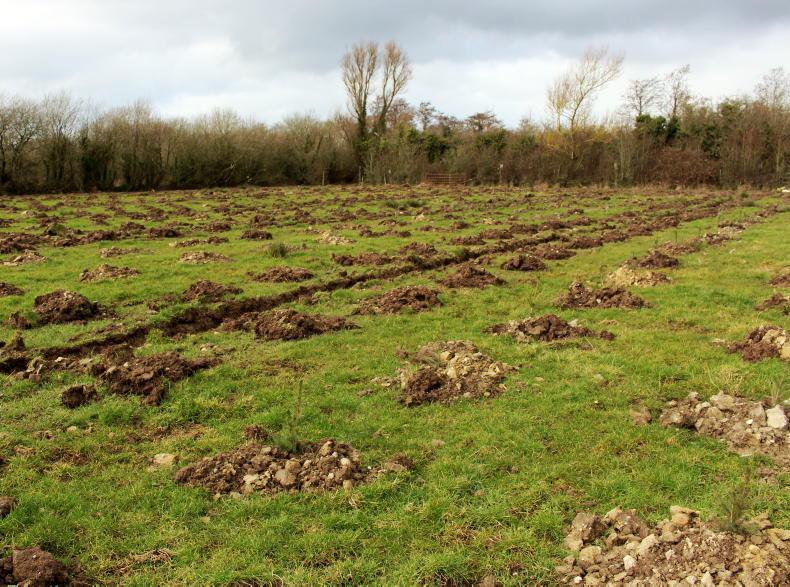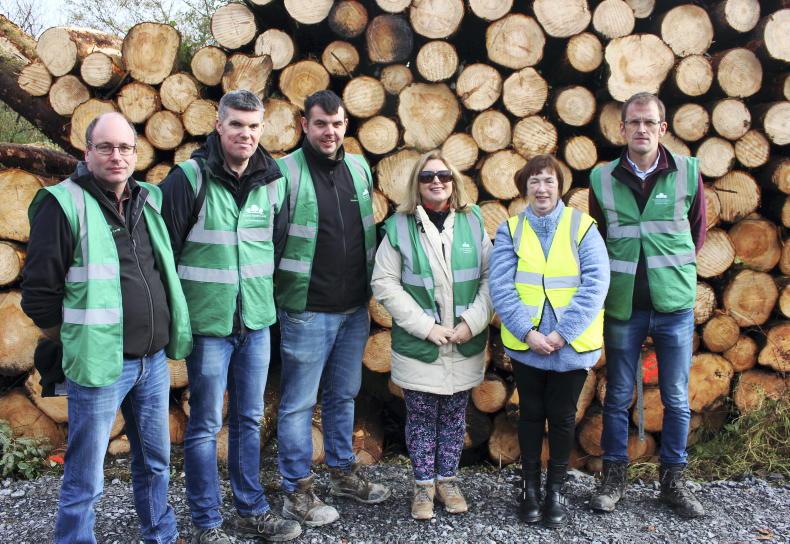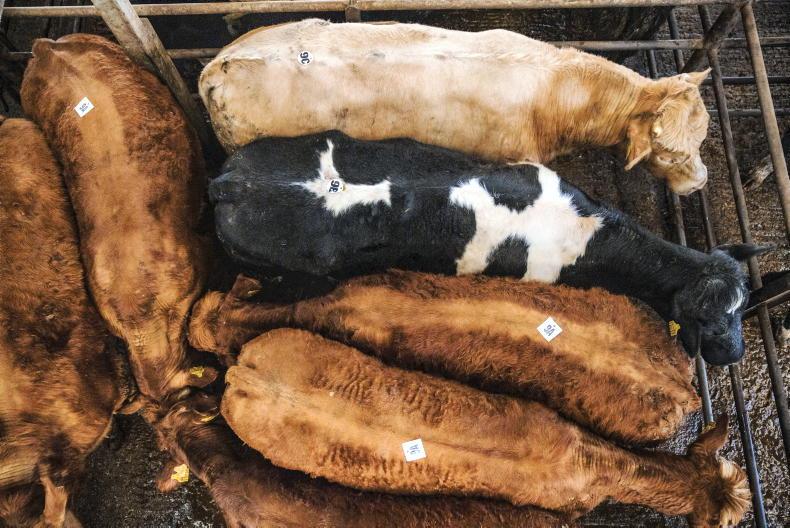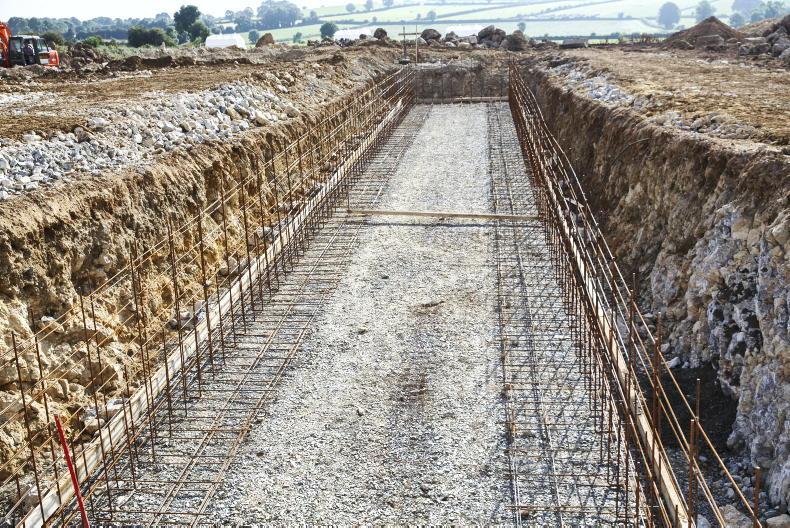The Department of Agriculture, Food and the Marine’s monthly forestry dashboard provides information on forestry licence trends, including data for afforestation, forest roads and felling licences.
These are provided by number of licences issued and area, and volume yield for felling licences. The dashboard also contains information on forest roads and progress on schemes such as the ash dieback reconstitution and underplanting scheme (RUS).
Afforestation
As the current planting season draws to a close, performance from January to May is a good indication of overall and projected annual outturn. Total planting for the first five months amounted to 1,016ha, marginally up on last year’s total and down on the 1,233ha planted in 2020 (Table 1).
More worrying is the lack of interest in afforestation by farmers and other landowners at present. This downward trend is clear from the number of licences issued. For the first five months, these are at an all-time low of 1,703ha, compared with 2,407ha last year and 1,974ha in 2020, which were well down on previous years.
There is an estimated 2:1 ratio between licences issued and actual planting for a variety of reasons, such as time delays in receiving licences, farmers opting for alternative schemes and land uses in the meantime, or a loss of interest and confidence in the current afforestation scheme.
When planting returns are combined with licences issued, the projected annual afforestation programme will struggle to achieve 2,000ha by year end. This falls 14,000ha short of the 16,000ha annual programme recommended by COFORD, if forestry is to play its part in Ireland’s Climate Action Plan to achieve net zero by 2050.
A spokesperson for one of the forestry companies said most farmers were no longer interested in forestry as a land use option. “Farmers may plant less than 10% of the depleted programme this year,” he said.
“Forestry companies are also turning their attention to other activities, while many forestry contractors have left the business,” he added. “A major promotional campaign is now required, but this has to be backed by a quick licence turnaround time and a rapid introduction of a revised afforestation programme.
“This would convince many landowners who have received afforestation licence approval to plant.”
Felling
The Department issued 138 felling licences to Coillte in May and 116 to private forest owners. This translates to 645,599m3 or 4,108ha harvested. Breakdowns of Coillte, private thinning and clearfells are not provided. The concerted efforts by the forest industry – Coillte, Forest Industries Ireland and Irish sawmills – and the Department’s response are paying dividends.
Licence numbers have trebled to 20,198 (Table 2) since 2020, while volumes so far in 2022 are estimated at 3.87m m3. It is difficult to predict how much of this will reach the market place in the coming year, as licences can be activated over a 10-year period.
The increased trend in licences issued has been welcomed by Coillte and the Irish sawmills.
Traolach Layton, forestry manager with GP Wood, said the increased volume is a positive development, but the dashboard data “contains a major flaw as it shows the total volumes per licence approved but gives no indication of what year this will be harvested”.
He suggested a more relevant form of forecasting. “For example, at present the total volume to be removed is recorded for the current year, where in reality it is likely to reach the marketplace in stages over a number of years, while the bulk of the volume – for clearfell – may not be available until the end of the 10-year licences.”
He pointed out that each licence application made to the Department shows the year of felling, area, harvesting type (thinning or clearfell) and volumes to be removed.
“Armed with this information, there is no reason why the Department couldn’t compile accurate annual forecasts for the industry so that sawmills can plan ahead based on real relevant information.”
Forest roads
Licences were issued for 130km of roads for the first five months this year, compared with 124km last year, while 33km were constructed up to May compared with 23km in 2021.
As road construction is not seasonal it is difficult to predict annual outturn, but at current rates, the annual programme is likely to exceed last year’s 70km.
Change to the to the ash reconstitution scheme
The Department of Agriculture, Food and the Marine has announced a change to the ash dieback Reconstitution and Underplanting Scheme (RUS) with ”immediate effect”. This removes “the requirement under the RUS for applicants to carry out a damage assessment” because of “the current widespread nature of the disease in ash plantations nationwide”.
The circular recommends that applications under RUS are accompanied by harvest plans. “This is a welcome if long overdue change,” said a spokesperson for one of the forestry companies. “However, it falls well short of what is required such as compensation by way of premium payments for those who have lost their ash plantations.”
He added that “ash plantation owners who wished to convert to conifers had their applications screened in for Appropriate Assessment”. He said: “These were now referred to their local authorities for planning permission.”
A Department spokesperson, acknowledging this condition as a stumbling block, said: “[The] Department is continuing to engage with the Department of Housing, Local Government and Heritage to remove the requirement for planning permission in all cases under 10ha.”
Only 50 RUS schemes had been approved by the Department for the first five months this year according to the monthly dashboard. The dashboard doesn’t provide information on applications received to date. In a reply to a question from Deputy Charlie Flanagan on October 12 last year, Minister McConalogue said: “The Department had received 386 applications for 1,558ha, of which decisions have issued on 125 for 432ha.”
Longford field day at mixed woodland
Forest certification, heritage and environment protection are topics covered in a field day this Friday in Mosstown, Co Longford. Organised by the Irish Timber Growers Association (ITGA) in association with the Irish Forestry Unit Trust (IForUT), the field day includes a visit to the hand built Irish oak prehistoric road at the Corlea Visitors Centre courtesy of the OPW. This is the largest road to have been uncovered in Europe.
The event also includes a visit to Mosstown 32ha mixed species woodland. The owners IForUT are currently working in partnership with Longford County Council and the community to develop the forest’s recreational facilities. Visitors will be briefed about forest management plans, forest certification and issues such as wildlife habitat protection.
While all are welcome, due to the nature of the location, pre-booking is required by email to info@itga.ie. The field day is supported by the Department under the Woodland Support Projects 2021-2022.
The Department of Agriculture, Food and the Marine’s monthly forestry dashboard provides information on forestry licence trends, including data for afforestation, forest roads and felling licences.
These are provided by number of licences issued and area, and volume yield for felling licences. The dashboard also contains information on forest roads and progress on schemes such as the ash dieback reconstitution and underplanting scheme (RUS).
Afforestation
As the current planting season draws to a close, performance from January to May is a good indication of overall and projected annual outturn. Total planting for the first five months amounted to 1,016ha, marginally up on last year’s total and down on the 1,233ha planted in 2020 (Table 1).
More worrying is the lack of interest in afforestation by farmers and other landowners at present. This downward trend is clear from the number of licences issued. For the first five months, these are at an all-time low of 1,703ha, compared with 2,407ha last year and 1,974ha in 2020, which were well down on previous years.
There is an estimated 2:1 ratio between licences issued and actual planting for a variety of reasons, such as time delays in receiving licences, farmers opting for alternative schemes and land uses in the meantime, or a loss of interest and confidence in the current afforestation scheme.
When planting returns are combined with licences issued, the projected annual afforestation programme will struggle to achieve 2,000ha by year end. This falls 14,000ha short of the 16,000ha annual programme recommended by COFORD, if forestry is to play its part in Ireland’s Climate Action Plan to achieve net zero by 2050.
A spokesperson for one of the forestry companies said most farmers were no longer interested in forestry as a land use option. “Farmers may plant less than 10% of the depleted programme this year,” he said.
“Forestry companies are also turning their attention to other activities, while many forestry contractors have left the business,” he added. “A major promotional campaign is now required, but this has to be backed by a quick licence turnaround time and a rapid introduction of a revised afforestation programme.
“This would convince many landowners who have received afforestation licence approval to plant.”
Felling
The Department issued 138 felling licences to Coillte in May and 116 to private forest owners. This translates to 645,599m3 or 4,108ha harvested. Breakdowns of Coillte, private thinning and clearfells are not provided. The concerted efforts by the forest industry – Coillte, Forest Industries Ireland and Irish sawmills – and the Department’s response are paying dividends.
Licence numbers have trebled to 20,198 (Table 2) since 2020, while volumes so far in 2022 are estimated at 3.87m m3. It is difficult to predict how much of this will reach the market place in the coming year, as licences can be activated over a 10-year period.
The increased trend in licences issued has been welcomed by Coillte and the Irish sawmills.
Traolach Layton, forestry manager with GP Wood, said the increased volume is a positive development, but the dashboard data “contains a major flaw as it shows the total volumes per licence approved but gives no indication of what year this will be harvested”.
He suggested a more relevant form of forecasting. “For example, at present the total volume to be removed is recorded for the current year, where in reality it is likely to reach the marketplace in stages over a number of years, while the bulk of the volume – for clearfell – may not be available until the end of the 10-year licences.”
He pointed out that each licence application made to the Department shows the year of felling, area, harvesting type (thinning or clearfell) and volumes to be removed.
“Armed with this information, there is no reason why the Department couldn’t compile accurate annual forecasts for the industry so that sawmills can plan ahead based on real relevant information.”
Forest roads
Licences were issued for 130km of roads for the first five months this year, compared with 124km last year, while 33km were constructed up to May compared with 23km in 2021.
As road construction is not seasonal it is difficult to predict annual outturn, but at current rates, the annual programme is likely to exceed last year’s 70km.
Change to the to the ash reconstitution scheme
The Department of Agriculture, Food and the Marine has announced a change to the ash dieback Reconstitution and Underplanting Scheme (RUS) with ”immediate effect”. This removes “the requirement under the RUS for applicants to carry out a damage assessment” because of “the current widespread nature of the disease in ash plantations nationwide”.
The circular recommends that applications under RUS are accompanied by harvest plans. “This is a welcome if long overdue change,” said a spokesperson for one of the forestry companies. “However, it falls well short of what is required such as compensation by way of premium payments for those who have lost their ash plantations.”
He added that “ash plantation owners who wished to convert to conifers had their applications screened in for Appropriate Assessment”. He said: “These were now referred to their local authorities for planning permission.”
A Department spokesperson, acknowledging this condition as a stumbling block, said: “[The] Department is continuing to engage with the Department of Housing, Local Government and Heritage to remove the requirement for planning permission in all cases under 10ha.”
Only 50 RUS schemes had been approved by the Department for the first five months this year according to the monthly dashboard. The dashboard doesn’t provide information on applications received to date. In a reply to a question from Deputy Charlie Flanagan on October 12 last year, Minister McConalogue said: “The Department had received 386 applications for 1,558ha, of which decisions have issued on 125 for 432ha.”
Longford field day at mixed woodland
Forest certification, heritage and environment protection are topics covered in a field day this Friday in Mosstown, Co Longford. Organised by the Irish Timber Growers Association (ITGA) in association with the Irish Forestry Unit Trust (IForUT), the field day includes a visit to the hand built Irish oak prehistoric road at the Corlea Visitors Centre courtesy of the OPW. This is the largest road to have been uncovered in Europe.
The event also includes a visit to Mosstown 32ha mixed species woodland. The owners IForUT are currently working in partnership with Longford County Council and the community to develop the forest’s recreational facilities. Visitors will be briefed about forest management plans, forest certification and issues such as wildlife habitat protection.
While all are welcome, due to the nature of the location, pre-booking is required by email to info@itga.ie. The field day is supported by the Department under the Woodland Support Projects 2021-2022.









SHARING OPTIONS